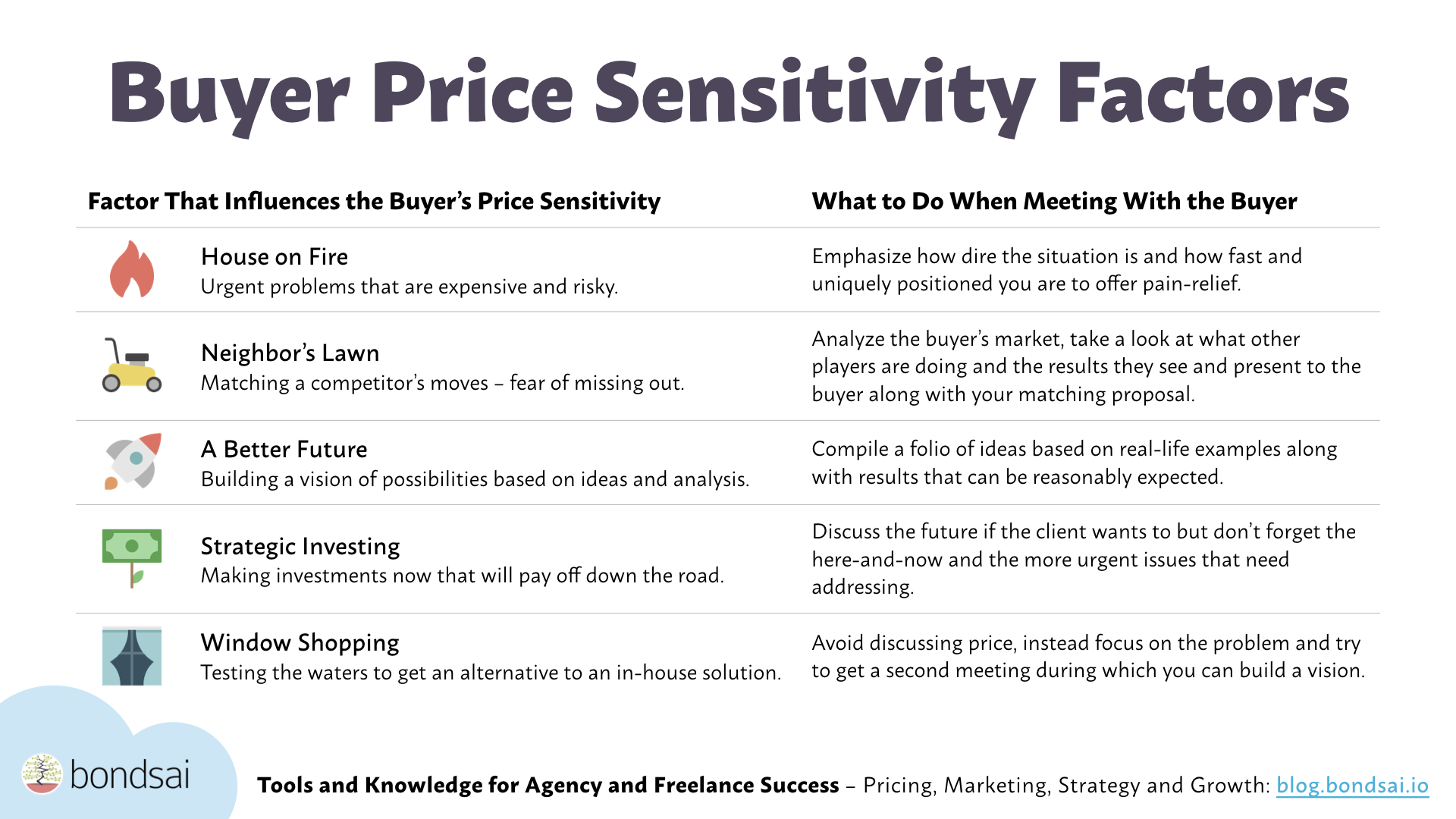
The basic idea of value-based pricing is that buyers pay for the value of what they receive. But how do you, as a seller, determine that value? What is the prospective client willing to pay? How price-sensitive are they?
This post is the second in our series on determining and setting value-based prices. I wrote this series to help more people overcome a major obstacle when adopting value-based pricing: price-setting.
In the previous post in this series, we discussed why it’s smart to break down projects into chunks. This post assumes you’ve already read that one so you’ll probably find this article useful if you read these posts in order.
This post is about factors that influence a buyer’s price sensitivity. Each of these factors influences the buyer’s sense of value. These factors taken together help you:
- Determine the price sensitivity of a buyer,
- Devise the best tactics to influence the buyer to see the value in your offering.
Understanding these factors and bringing this perspective to sales conversations doesn’t only help you shape buyer perceptions and price sensitivity. It’s also an effective antidote to other sellers that try to win through underbidding. By not engaging in that race to the bottom and instead influencing the factors that motivate or scare the buyer, you can walk out a winner without having to compromise with price.
Factor 1: The House on Fire Scenario – Effective but Rare

Imagine you’re in the department store and they have a sale on fire extinguishers. You’ve been thinking of buying one but you also doubt whether you’ll need it. After all, you consider yourself a careful and responsible person. Your fireplace is well-built, recently inspected and you’d never leave a fire or hot coals unattended. After a quick deliberation with yourself, you decide to skip it for now and reconsider in the future when you have a bit more money to spare.
Some weeks later you wake up in the middle of the night. There’s a smell of burning in the air. Your worst fears materialize as you rush into your kitchen to discover a fire. “Damn, if I only knew!” you think as you regret your decision not to buy a fire extinguisher when you had the chance. Your earlier decision, based on a split-second probability analysis and cheapness, seems so stupid. You’d have paid 3 times the asking price if you’d have known better. In other words, the urgency of the situation reduced your price sensitivity by 66%!
Chances are that some of your clients find themselves in similar situations but on a different scale. For example, by not investing in a security review of their website, they get hacked and have their innermost secrets made public.
The Power of Nuclear Events
As we discussed in a previous post about such “nuclear events,” using risk- and pain-based scenarios in your marketing or sales conversations can be highly profitable. Generally speaking, removing pain and helping your buyer avoid risk are the most persuasive arguments you can use to lower someone’s price sensitivity.
Some buyers who approach you are putting out fires as they happen. If you know this is the case, your best tactic is to emphasize the costs and risks they’re subject to as you speak.
Principle: The value of your offer is determined based on whether it helps avoid potential pain or remove (urgent) pain.
Factor 2: The Neighbor’s Emerald Lawn – The (Sometimes) Irrational Fear of Competitors

Businesses are surprisingly irrational. It’s natural, they’re run by people after all. The same people that compete with their neighbors for the reddest roses or having the latest model Mercedes.
Irrational fears manifest themselves in other ways too, for example in how companies view competitors. A fair share of marketing is done to intimidate and match competitors. It’s often done with the excuse of “positioning us in the minds of a key target market” or such business-like jargon.
In the past, that didn’t seem to matter. In the famous words of John Wanamaker “Half the money I spend on advertising is wasted; the trouble is I don’t know which half” (turns out it’s not that simple but that’s a story for a different time).
That idea fed many of the great “mad men” advertising agencies of the ‘40s, ‘50s, and ‘60s. As long as the business was growing, no one dared touch the enormous advertising budgets of which the agencies usually received a fixed 15% cut. The huge advertising accounts and the agency profits this resulted in made it possible for advertising legend David Ogilvy to buy a French castle to retire to.
The Fear of Missing Out
Today, with digital marketing and a whole set of tools for attribution, things are less mysterious. We know where people click, and scarily often even why. Even so, pointing out to your buyer what their arch-nemesis is doing can be highly motivating and help reduce price sensitivity. Chances are they’re watching their every move. Ready to match. After all, if their opponent is doing something it has to be a for a reason.
Before meeting with a new buyer or responding to a request, take a look at the market they operate in. Understand which the key players are what they’re currently doing. Don’t be arrogant and presume to know more than your buyer does. Simply come to the meeting prepared, informed and genuinely curious. Point out things their competitors are doing and which are similar to your idea or proposal.
Principle: Companies will often match their competitors’ moves, frequently without deeper analysis, driven by a fear of missing out.
Factor 3: A Better Future, Promises of Improvements and Profit – Energizing But Rarely a Priority

If avoiding pain is the strongest motivator, then winning gets the bronze. Many buyers are receptive to ideas for improving their business. They’re eager to hear your take on ways to improve. When falling on the right ears, great ideas eat price sensitivity.
These are the most rewarding clients to work with. Planning and idea sessions are often creative, optimistic and characterized by a desire to do great work.
Help Your Buyers Win the Fight for You
While ideas will energize them, what will help them loosen their purse strings and further reduce their price sensitivity are measurable results. The person sitting across from you could be the most visionary person at their company. But they will almost always answer to someone less inclined to flights of fancy. The better you can prepare them to win the cynics over, the higher your chances of winning work.
To get mindshare from a visionary buyer, prepare a folio of ideas backed up with concrete examples and numbers. These usually don’t have to be exact. You can use examples from other businesses and show the results these companies have achieved. Buyers are often more interested in seeing that you are aware of the bottom-line, rather than that you can make exact projections.
Principle: Buyers looking for someone who can help them take their business to the next level are looking for concrete suggestions backed up by evidence.
Factor 4: Strategic Investing and Long-Term Return – Not As Valuable As You May Think

Many agencies and freelancers refer to themselves as “strategic,” accompanied by the notion that it somehow makes them stand out. At a time, it did. That was back when it meant something.
Today, however, being “strategic” usually translates to a penchant for client workshops. That’s not a criticism of workshops per se. I love workshops. But a poorly executed workshop along with a project that focuses on deliverables taken off a backlog don’t make you a master strategist, wanted for your advice.
Furthermore, with an abundance of self-appointed “strategists,” the value of strategy is diminishing. Yes, clients want your input and ideas but if that’s all you provide, their price sensitivity won’t change.
My take on it: buyers almost never buy services for the sake of strategy. Do not lead with “strategy” or being “strategic.” Instead, discover the actual pains or problems that you can help fix and suggest well thought-out ways to solve them.
Instead of promising future returns, it’s almost always better to focus on the here and present. Quick and fast wins will help you gain trust and position you as someone whose advice is worth taking.
Principle: Strategic projects and advice are inherently more valuable as they increase the likelihood of higher return over time.
Factor 5: Window-Shopping – The Dangers of Promising Too Much, Too Early to Uncommitted Buyers

The reasons for starting a project or requesting a proposal are many. Some are the result of issues that need to be addressed immediately, while others are more speculative. As you’re probably aware, some buyers are in the latter category – they’re window-shopping.
These buyers test the waters to see what’s out there. Sometimes they’re at the cusp of committing to an in-house project and want an alternative to compare with. In other cases, it’s a straight-out attempt to get free ideas from you to augment whatever they have planned for themselves. This is in fact rather common and I’ve been on both sides, seeing it happen.
While it can be frustrating for a seller, it’s normal and not something to frown upon. Some of these early buyer probes can turn into real work in the future. Dismissing them outright comes with the risk of missing out on some fun and rewarding projects.
While these meetings aren’t necessarily a waste of time, many make the mistake of spending too much time on them. It’s important to determine what the buyer is looking for so you can adjust the conversation and your expectations. Some buyers have unrealistic expectations at this stage and a price sensitivity to match.
To Spec or Not to Spec
Inexperienced buyers, or those who feel entitled, might demand that you do work on spec. That is work that’s done without a promise of compensation. Whether you choose to is your choice. Spec work can lead to real work. However, I strongly advise that any investment of your time is done after you’ve made a level-headed analysis and qualified the client first.
This is usually not the right time to discuss price. Details are often scarce and the buyer is usually weighing their options. Whatever price you mention can be used against you in the future. Either for them to justify going with an alternative option or being presented to you as a promise you’ve made.
Prices discussed at this point do not have any context. Any price presented here will not match any expressed need, problem or pain. As such, it will be a number. Nothing less, nothing more. As I’ve discussed earlier, numbers without context are just asking to be driven into the ground. Pushed down until you bleed. Any price is too high. Price sensitivity is at max.
The reason I mention this factor is because many buyers are at this point while the seller assumes they’re much further ahead. Accurately determining the buyer’s progress helps you avoid the mistake of presenting a price before establishing a context and helping the buyer visualize a scenario.
Principle: Buyers at early stages are frequently window-shopping in an attempt to get a price for reference, reducing you to a “Column B.”
Using the 5 Factors to Lower Price Sensitivity Through Conversations With Buyers
The list of factors above isn’t complete. There are more. But these five are some of the most common and worth remembering. By bringing an awareness of these to a meeting with a buyer, you can shape the conversation to make your buyer see more value in what you’re offering, thereby lowering their price sensitivity.
Download Our Free Printable Infographic of Factors that Influence the Price Sensitivity of Buyers
I’ve made an infographic that sums the five factors and suitable tactics in a handy reference format:

Click it to view the full size version.
Feel free to print it or share it with colleagues or friends.
Bottom Line: It Doesn’t Matter How Hard You Work If It Doesn’t Benefit the Buyer
Some years ago I was consulting with a large company. I was helping them to improve a complex manual process that took considerable time to perform. One of the specialists in the project team said, with some exasperation, “if only our customers knew how long this [process] takes!”
Chances are they wouldn’t care one bit.
Value is subjective. It’s only the buyer who can decide what is valuable and what is not. That means that you need to frame what you’re selling in a way that makes it valuable to them, keeping in mind the factors that put them in that seat in front of you.
